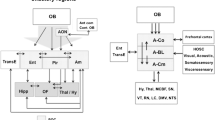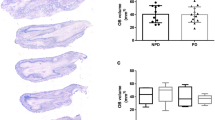Abstract
Involvement of the olfactory bulb by Lewy-type α-synucleinopathy (LTS) is known to occur at an early stage of Parkinson’s disease (PD) and Lewy body disorders and is therefore of potential usefulness diagnostically. An accurate estimate of the specificity and sensitivity of this change has not previously been available. We performed immunohistochemical α-synuclein staining of the olfactory bulb in 328 deceased individuals. All cases had received an initial neuropathological examination that included α-synuclein immunohistochemical staining on sections from brainstem, limbic and neocortical regions, but excluded olfactory bulb. These cases had been classified based on their clinical characteristics and brain regional distribution and density of LTS, as PD, dementia with Lewy bodies (DLB), Alzheimer’s disease with LTS (ADLS), Alzheimer’s disease without LTS (ADNLS), incidental Lewy body disease (ILBD) and elderly control subjects. The numbers of cases found to be positive and negative, respectively, for olfactory bulb LTS were: PD 55/3; DLB 34/1; ADLS 37/5; ADNLS 19/84; ILBD 14/7; elderly control subjects 5/64. The sensitivities and specificities were, respectively: 95 and 91% for PD versus elderly control; 97 and 91% for DLB versus elderly control; 88 and 91% for ADLS versus elderly control; 88 and 81% for ADLS versus ADNLS; 67 and 91% for ILBD versus elderly control. Olfactory bulb synucleinopathy density scores correlated significantly with synucleinopathy scores in all other brain regions (Spearman R values between 0.46 and 0.78) as well as with scores on the Mini-Mental State Examination and Part 3 of the Unified Parkinson’s Disease Rating Scale (Spearman R −0.27, 0.35, respectively). It is concluded that olfactory bulb LTS accurately predicts the presence of LTS in other brain regions. It is suggested that olfactory bulb biopsy be considered to confirm the diagnosis in PD subjects being assessed for surgical therapy.

Similar content being viewed by others
References
Adler CH (2005) Nonmotor complications in Parkinson’s disease. Mov Disord 20 Suppl 11:S23–S29
Beach TG, Adler CH, Sue LI, Peirce JB, Bachalakuri J, sing-Hernandez JE, Lue LF, Caviness JN, Connor DJ, Sabbagh MN, Walker DG (2008) Reduced striatal tyrosine hydroxylase in incidental Lewy body disease. Acta Neuropathol 115:445–451
Beach TG, Sue LI, Walker DG, Roher AE, Lue L, Vedders L, Connor DJ, Sabbagh MN, Rogers J (2007) The Sun Health Research Institute Brain Donation Program: description and experience, 1987–2007. Cell Tissue Bank
Beach TG, Tago H, Nagai T, Kimura H, McGeer PL, McGeer EG (1987) Perfusion-fixation of the human brain for immunohistochemistry: comparison with immersion-fixation. J Neurosci Methods 19:183–192
Bloch A, Probst A, Bissig H, Adams H, Tolnay M (2006) Alpha-synuclein pathology of the spinal and peripheral autonomic nervous system in neurologically unimpaired elderly subjects. Neuropathol Appl Neurobiol 32:284–295
Braak H, Bohl JR, Muller CM, Rub U, de Vos RA, Del TK (2006) Stanley Fahn Lecture 2005: the staging procedure for the inclusion body pathology associated with sporadic Parkinson’s disease reconsidered. Mov Disord 21:2042–2051
Braak H, Del Tredici K, Bratzke H, Hamm-Clement J, Sandmann-Keil D, Rub U (2002) Staging of the intracerebral inclusion body pathology associated with idiopathic Parkinson’s disease (preclinical and clinical stages). J Neurol 249 Suppl 3:1–5
Cornford ME, Chang L, Miller BL (1995) The neuropathology of Parkinsonism: an overview. Brain Cogn 28:321–341
Daniel SE, Hawkes CH (1992) Preliminary diagnosis of Parkinson’s disease by olfactory bulb pathology. Lancet 340:186
Doty RL, Deems DA, Stellar S (1988) Olfactory dysfunction in Parkinsonism: a general deficit unrelated to neurologic signs, disease stage, or disease duration. Neurology 38:1237–1244
Fujishiro H, Tsuboi Y, Lin WL, Uchikado H, Dickson DW (2008) Co-localization of tau and alpha-synuclein in the olfactory bulb in Alzheimer’s disease with amygdala Lewy bodies. Acta Neuropathol 116:17–24
Fujiwara H, Hasegawa M, Dohmae N, Kawashima A, Masliah E, Goldberg MS, Shen J, Takio K, Iwatsubo T (2002) Alpha-Synuclein is phosphorylated in synucleinopathy lesions. Nat Cell Biol 4:160–164
Gelb DJ, Oliver E, Gilman S (1999) Diagnostic criteria for Parkinson disease. Arch Neurol 56:33–39
Gibb WR (1992) Neuropathology of Parkinson’s disease and related syndromes. Neurol Clin 10:361–376
Gill CE, Konrad PE, Davis TL, Charles D (2007) Deep brain stimulation for Parkinson’s disease: the Vanderbilt University Medical Center experience, 1998–2004. Tenn Med 100:45–47
Harbaugh RE (1985) Brain biopsy in Alzheimer’s disease: surgical technique and indications. Bull Clin Neurosci 50:39–43
Hawkes C (2006) Olfaction in neurodegenerative disorder. Adv Otorhinolaryngol 63:133–151
Hladik CL, White CL (2003) Comparison of digestive enzyme and formic acid pretreatment for optimal immunohistochemical demonstration of alpha-synuclein-immunoreactive cerebral cortical Lewy neurites. J Neuropathol Exp Neurol 62:554
Hubbard PS, Esiri MM, Reading M, McShane R, Nagy Z (2007) Alpha-synuclein pathology in the olfactory pathways of dementia patients. J Anat 211:117–124
Hughes AJ, Daniel SE, Kilford L, Lees AJ (1992) Accuracy of clinical diagnosis of idiopathic Parkinson’s disease: a clinico-pathological study of 100 cases. J Neurol Neurosurg Psychiatry 55:181–184
Hughes AJ, Daniel SE, Lees AJ (2001) Improved accuracy of clinical diagnosis of Lewy body Parkinson’s disease. Neurology 57:1497–1499
Katzenschlager R, Lees AJ (2004) Olfaction and Parkinson’s syndromes: its role in differential diagnosis. Curr Opin Neurol 17:417–423
Kovacs T, Papp MI, Cairns NJ, Khan MN, Lantos PL (2003) Olfactory bulb in multiple system atrophy. Mov Disord 18:938–942
Kranick SM, Duda JE (2008) Olfactory dysfunction in Parkinson’s disease. Neurosignals 16:35–40
Lang AE, Houeto JL, Krack P, Kubu C, Lyons KE, Moro E, Ondo W, Pahwa R, Poewe W, Troster AI, Uitti R, Voon V (2006) Deep brain stimulation: preoperative issues. Mov Disord 21 Suppl 14:S171–S196
Linazasoro G (2008) Olfaction testing in PD: risky conclusions. Mov Disord 23:1060
Litvan I, MacIntyre A, Goetz CG, Wenning GK, Jellinger K, Verny M, Bartko JJ, Jankovic J, McKee A, Brandel JP, Chaudhuri KR, Lai EC, D’Olhaberriague L, Pearce RK, Agid Y (1998) Accuracy of the clinical diagnoses of Lewy body disease, Parkinson disease, and dementia with Lewy bodies: a clinicopathologic study. Arch Neurol 55:969–978
Mahendra B (1984) Some ethical issues in dementia research. J Med Ethics 10:29–31
Master Z, McLeod M, Mendez I (2007) Benefits, risks and ethical considerations in translation of stem cell research to clinical applications in Parkinson’s disease. J Med Ethics 33:169–173
McKeith IG, Dickson DW, Lowe J, Emre M, O’Brien JT, Feldman H, Cummings J, Duda JE, Lippa C, Perry EK, Aarsland D, Arai H, Ballard CG, Boeve B, Burn DJ, Costa D, Del ST, Dubois B, Galasko D, Gauthier S, Goetz CG, Gomez-Tortosa E, Halliday G, Hansen LA, Hardy J, Iwatsubo T, Kalaria RN, Kaufer D, Kenny RA, Korczyn A, Kosaka K, Lee VM, Lees A, Litvan I, Londos E, Lopez OL, Minoshima S, Mizuno Y, Molina JA, Mukaetova-Ladinska EB, Pasquier F, Perry RH, Schulz JB, Trojanowski JQ, Yamada M (2005) Diagnosis and management of dementia with Lewy bodies: third report of the DLB Consortium. Neurology 65:1863–1872
McKeith IG, Galasko D, Kosaka K, Perry EK, Dickson DW, Hansen LA, Salmon DP, Lowe J, Mirra SS, Byrne EJ, Lennox G, Quinn NP, Edwardson JA, Ince PG, Bergeron C, Burns A, Miller BL, Lovestone S, Collerton D, Jansen EN, Ballard C, de Vos RA, Wilcock GK, Jellinger KA, Perry RH (1996) Consensus guidelines for the clinical and pathologic diagnosis of dementia with Lewy bodies (DLB): report of the consortium on DLB international workshop. Neurology 47:1113–1124
McKinnon JH, Demaerschalk BM, Caviness JN, Wellik KE, Adler CH, Wingerchuk DM (2007) Sniffing out Parkinson disease: can olfactory testing differentiate Parkinsonian disorders? Neurologist 13:382–385
Obeso JA, Rodriguez MC, Gorospe A, Guridi J, Alvarez L, Macias R (1997) Surgical treatment of Parkinson’s disease. Baillieres Clin Neurol 6:125–145
Paluzzi A, Belli A, Bain P, Liu X, Aziz TM (2006) Operative and hardware complications of deep brain stimulation for movement disorders. Br J Neurosurg 20:290–295
Pearce RK, Hawkes CH, Daniel SE (1995) The anterior olfactory nucleus in Parkinson’s disease. Mov Disord 10:283–287
Rodriguez RL, Fernandez HH, Haq I, Okun MS (2007) Pearls in patient selection for deep brain stimulation. Neurologist 13:253–260
Seijo FJ, varez-Vega MA, Gutierrez JC, Fdez-Glez F, Lozano B (2007) Complications in subthalamic nucleus stimulation surgery for treatment of Parkinson’s disease. Review of 272 procedures. Acta Neurochir (Wien) 149:867–875
Subramanian T (2001) Cell transplantation for the treatment of Parkinson’s disease. Semin Neurol 21:103–115
Tir M, Devos D, Blond S, Touzet G, Reyns N, Duhamel A, Waucquier N, Cottencin O, Dujardin K, Debailleul AM, Cassim F, Destee A, Defebvre L, Krystkowiak P (2007) Exhaustive, one-year follow-up of subthalamic nucleus deep brain stimulation in a large, single-center cohort of parkinsonian patients. Neurosurgery
The National Institute on Aging, and Reagan Institute Working Group on Diagnostic Criteria for the Neuropathological Assessment of Alzheimer’s Disease (1997) Consensus recommendations for the postmortem diagnosis of Alzheimer’s disease. Neurobiol Aging 18:S1–S2
Acknowledgments
We wish to acknowledge all of the other members of the Arizona Parkinson’s Disease Consortium, including John Caviness MD, Virgilio Evidente MD, Erika Driver-Dunckley MD, Padma Mahant MD, and Johan Samanta MD. This research is supported by grants to the Sun Health Research Institute Brain Donation Program and the Arizona Parkinson’s Disease Consortium by the Michael J. Fox Foundation for Parkinson’s Research (The Prescott Family Initiative), the Arizona Biomedical Research Commission (contracts 4001, 0011 and 05-901) and the National Institute on Aging (P30 AG19610).
Conflict of interest statement
All authors have declared that they have no competing interests.
Author information
Authors and Affiliations
Consortia
Corresponding author
Rights and permissions
About this article
Cite this article
Beach, T.G., White, C.L., Hladik, C.L. et al. Olfactory bulb α-synucleinopathy has high specificity and sensitivity for Lewy body disorders. Acta Neuropathol 117, 169–174 (2009). https://doi.org/10.1007/s00401-008-0450-7
Received:
Revised:
Accepted:
Published:
Issue Date:
DOI: https://doi.org/10.1007/s00401-008-0450-7




